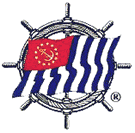Click
the answers that you think are correct — see how your
knowledge stacks up!
1. A displacement hull is one that:
2. When you shop for a boat, the following important questions should
be addressed: 1) What type and style will best serve your use of a
boat? 2) How large a boat will you need for the number of persons that
accompany you?, and 3):
3. The fitting through which the shaft of an inboard engine passes
through the hull should be checked frequently because it could:
4. A spring line is a dock line that:
5. Under normal conditions, the recommended scope of an anchor line
is approximately:
6. The skipper of a boat is obligated by law to provide assistance to
any individual in danger at sea providing that the:
7. Most states require that water ski boats have two persons aboard;
the operator and _______.
8. If on the water and a hurricane is predicted, the best advice is to:
9. A can buoy will be _______in shape and shown on a chart as a ______.
10. Charts of tidal waters always show vertical clearances of overhead
objects at:
11. A type of boat that is more difficult to control at high speeds than
most other boats is the:
12. Tide rises:
13. When you enter a lock, be sure to:
14. An important safety rule when tying up in a lock is:
15. Constantly watch the wake of your boat, because:
16. The feature of a life preserver that keeps a person afloat is its:
17. In addition to keeping your flame arrestor free of damage, it is
important to:
18. Navigation lights most frequently found on sailing vessels under
65.6 feet include a white sternlight and:
19. Fire extinguishers should be mounted in strategic locations.
Recommended locations are near the galley,engine compartment, helm,
and:
20. While operating in a thick fog, you hear one prolonged blast every
two minutes off your starboard bow. You proceed slowly and watch for a
_____________ ahead of you.

